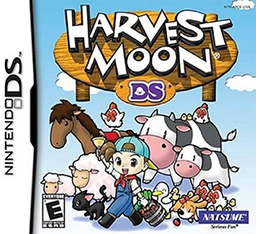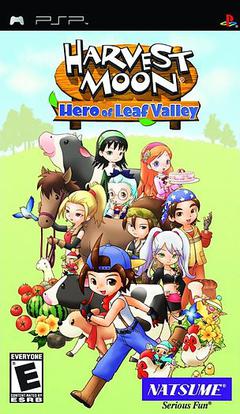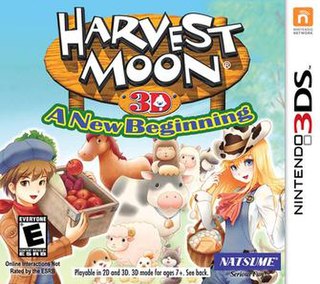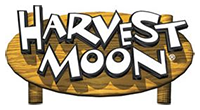Story of Seasons, known in Japan as Bokujō Monogatari and formerly known as Harvest Moon, is an agricultural simulation role-playing video game series created by Yasuhiro Wada and developed by Victor Interactive Software. Story of Seasons was the first game to be released under the new international series title of the same name.

Harvest Moon: A Wonderful Life is a video game that was released in Japan in September 2003 and March 2004 in North America for the GameCube. It was developed and published by Marvelous Interactive, and is part of the long-running Story of Seasons series of video games. The GameCube version offers connectivity with the Game Boy Advance game, Harvest Moon: Friends of Mineral Town.

Harvest Moon 64, released in Japan as Bokujō Monogatari 2 (牧場物語2), is a 1999 farm simulation video game developed by Victor Interactive Software for the Nintendo 64 console. It was published by Victor Interactive in Japan and by Natsume Inc. in North America. It is the third game in the Story of Seasons series.

Harvest Moon, known in Japan as Farm Story, is a farm simulation role-playing video game developed by Amccus for the Super Nintendo Entertainment System. The game first was released in Japan by Pack-In-Video in 1996, in North America by Natsume Inc. in 1997, and in Europe by Nintendo in 1998. The European version shipped with language localizations for Germany and France. It is the first game in the long-running Story of Seasons video game series, previously known as the Harvest Moon series in western territories. The game has been re-released on the Satellaview, Nintendo 3DS, Wii, Wii U and Nintendo Switch.

Harvest Moon 2 GBC, released in Japan as Bokujō Monogatari GB2 (牧場物語GB2), is a farm simulation video game for the Game Boy Color developed and published by Victor Interactive Software, and the second portable game in the Story of Seasons series. The object of the game is to cultivate a farm to prevent the land from being used to build an amusement park. As with the previous game, the player may choose to play as a boy or a girl.

Harvest Moon 3 GBC is a farm simulation video game for the Game Boy Color developed and published by Victor Interactive Software, part of the long-running Story of Seasons series of video games. The game was released for the Nintendo 3DS via Virtual Console in North America on December 11, 2014.

Harvest Moon: Back to Nature, known in Japan as Bokujō Monogatari Harvest Moon, is a video game in the farm simulation series Story of Seasons, developed and published by Victor Interactive Software. It is the first Harvest Moon game for a non-Nintendo console. Characters from Harvest Moon 64 were transferred to be the characters in this game, although with new lifestyles, personalities, and relatives.

Harvest Moon: Magical Melody is a social simulation video game for the GameCube developed by Marvelous Interactive. It is an updated version of Bokujō Monogatari: Shiawase no Uta, which was released on March 3, 2005 in Japan. The updated GameCube version was released in the United States by Natsume Inc. on March 28, 2006.

Rune Factory: A Fantasy Harvest Moon is a simulation role-playing video game developed by Neverland and published by Marvelous Interactive Inc., Natsume Inc., and Rising Star Games for the Nintendo DS handheld video game console.

Harvest Moon DS, known in Japan as Bokujō Monogatari: Colobocle Station, is a farm simulation role-playing video game for the Nintendo DS, part of the Story of Seasons series. It was published and developed by Marvelous Interactive Inc., and released in Japan on March 17, 2005, and in North America on September 12, 2006. It is the first entry in the series without series creator Yasuhiro Wada heavily involved, though it borrows many assets from Harvest Moon: Friends of Mineral Town and Harvest Moon: A Wonderful Life, such as the graphical style from the former and setting of the latter.
Rune Factory is a franchise of fantasy role-playing simulation games created by Yoshifumi Hashimoto and primarily published by Marvelous. The games are developed by Hashimoto's studio Hakama, taking over from Neverland after they ceased operations in 2013. The series began as a spin-off to Marvelous' flagship franchise Story of Seasons. The Story of Seasons references were subsequently dropped starting with the second installment, in order to become its own series. With the first game published in 2006, the property consists of five main-series games, two spin-off titles and numerous manga adaptations.

Harvest Moon DS: Sunshine Islands, is a video game that was released on February 21, 2008 in Japan and November 10, 2009 in North America. The seventeenth installment of the Story of Seasons series, and the fourth available for the Nintendo DS, the game closely resembles Harvest Moon DS: Island of Happiness; a section of the island from Harvest Moon: Island of Happiness is one of multiple islands in this game. The player can choose to be a boy (Mark) or a girl (Chelsea).

Harvest Moon DS: Grand Bazaar, known in Japan as Bokujō Monogatari: Yōkoso! Kaze no Bazaar e, is a simulation role-playing video game released on December 18, 2008 by Marvelous Interactive in Japan, and released on August 24, 2010 by Natsume Inc. in North America. It was released in Europe on September 30, 2011 by Rising Star Games. The game is the nineteenth game in the Story of Seasons series and the fifth game in the series for the Nintendo DS.

Harvest Moon: The Tale of Two Towns is a farming simulation video game developed by Marvelous Entertainment for the Nintendo DS and 3DS as part of the Story of Seasons series. It was released in North America on the Nintendo DS on September 20, 2011 and on the Nintendo 3DS on November 1, 2011 by Natsume Inc. The original release date for the Japanese version was set to February 25, 2010 but was moved to July 8, 2010.

Harvest Moon: Hero of Leaf Valley, known in Japan as Bokujō Monogatari: Sugar Mura to Minna no Negai, is a video game in the farm simulation series Harvest Moon for PlayStation Portable, developed by Marvelous Interactive Inc. and published by Natsume Inc. in the U.S. It was released on March 19, 2009 in Japan and on April 26, 2010 in North America.

Harvest Moon 3D: A New Beginning is a game for the Nintendo 3DS released by Natsume Inc. It is the last entry in the franchise released on the Nintendo 3DS systems to receive the title of Harvest Moon.

Harvest Moon is a farm simulation role-playing video game series published by Natsume Inc. The main objective of the games is to rebuild a run-down old farm and turn it into a successful one.

Story of Seasons: Trio of Towns, known in Japan as Bokujō Monogatari: Mittsu no Sato no Taisetsuna Tomodachi, is a farming simulation role-playing game developed by Marvelous for the Nintendo 3DS. The game was released in June 2016 in Japan, February 2017 in North America, and in October 2017 in Europe and Australia. In this installment, in addition to the usual farmland which the player owns, the player is able to visit three towns, each with their own distinct culture and lifestyles.

















